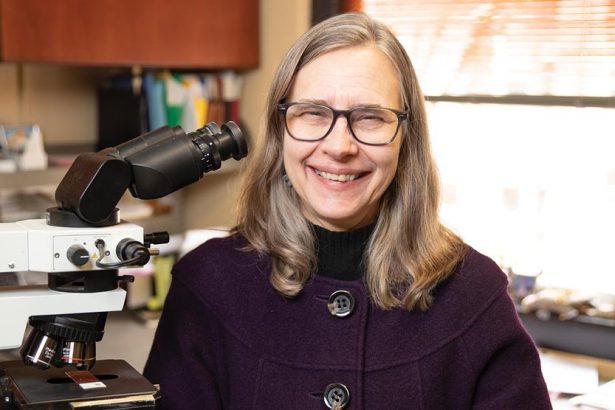National Leader
April 29, 2022

We’re unlikely as patients to ever meet a pathologist, those doctors who, having examined samples of our blood or tissue, write reports and speak with our attending physicians about what’s fundamentally going on with our cases.
When it comes to cancer treatment, how involved are these doctors? Take it from an oncologist: “The role of a pathologist is fundamental in the care of our patients,” said Cathy Eng, MD, David H. Johnson Professor of Surgical and Medical Oncology and co-director of Gastrointestinal Oncology at Vanderbilt-Ingram Cancer Center.
Surgical pathologist Kay Washington, MD, PhD, professor of Pathology, Microbiology and Immunology, “exemplifies an expert pathologist,” Eng said, “and is likely one of the most respected in her field.”
There are two main branches of pathology, Washington explained — clinical and anatomical. The former is focused on laboratory analysis of blood, urine and other bodily fluids. While board-certified in both areas, she works in anatomical pathology, of which surgical pathology is a subspecialty focused on examination of tissue removed from patients. Her particular area is diseases of the gastrointestinal tract and liver, mainly cancer and inflammatory disease.
“When a treating physician sees a mass and biopsies it, the surgical pathologist looks at the tissue under the microscope and makes a diagnosis,” Washington said. “If a cancer patient subsequently goes to surgery and the cancer is removed, the pathologist looks at the surgical specimen under the microscope, confirms the original diagnosis and determines the extent of the cancer.”
Medical oncologists combine pathology reports with radiology reports and other findings to determine the current stage of the patient’s cancer.
Washington chairs the editorial committee for the bible of cancer staging, the “AJCC Cancer Staging Manual,” published by the American Joint Committee on Cancer. For the College of American Pathologists, she chairs a committee charged with developing evidence-based practice guidelines for the field. And she directs the Western Division of the National Cancer Institute’s Cooperative Human Tissue Network; the division, with oversight from coordinator Kerry Wiles, collects and ships to researchers some 6,000 patient samples per year.
The workload of a typical academic surgical pathologist is 3,000 to 5,000 cases per year, Washington said. “My caseload is a mixture of very easy, quick cases and very complicated cancer surgical cases.”
In 30 years of practice, Washington has seen a change in the character of the patient reports written by pathologists. Where today’s pathology reports are made up of structured data, to the point of being machine readable and thus automatically digestible by electronic cancer registries, they used to be rather free- form.
“Anatomic and surgical pathology was always just kind of the Wild West,” she said. “It was a narrative prose report, and you could set it out however you wanted. If you didn’t quite know what you were doing, you might not even include the appropriate information for staging.” Thanks in large part to the influence of the College of American Pathologists, those days are over. “Some of the information in today’s reports that wasn’t routinely reported 25 years ago now actually drives or can influence treatment.”
As science advances upon molecular drivers of different cancers, clinical testing for molecular alterations in cancer has come online over the past decade to help clinicians match patients to newer treatments — and this too is part of the surgical pathologist’s province. “Along with examining the specimen directly, the pathologist is kind of key in triaging the specimen and having it sent to the appropriate laboratories,” Washington said.
When it comes to cancer research, pathologists tend to be interested in cancer subtyping, she said. Through participation in initiatives like The Cancer Genome Atlas Program, for example, pathologists have helped to correlate the appearance of various types of cancer tumors with their genetic mutations. “In terms of my own work, it really is focused on looking for similarities and differences across individual tumors,” she said.
As an aside, Washington mentioned she’s currently assisting an international project to standardize cancer tumor names. “People will probably be shocked that these terms weren’t already standardized.”
Cancer pathologists are also involved in biomarker research. “For instance, immune cells that infiltrate the tumor, what do they mean? Are they fighting the tumor or are they actually recruited by the tumor to help it invade? And what proteins do the immune cells and the tumor cells express that either help fight the tumor or help it grow?”
Washington applied to medical school after deciding it was “the best way to learn human biology.” Having received her MD and PhD from the University of North Carolina, Chapel Hill, she thought she should, out of principle, go elsewhere for her residency, so she drove over to a neighboring county, to Duke University. “Having done a rotation through the surgical pathology lab, I saw that as a way to really dive into human biology. And cancer biology was always an interest.”
